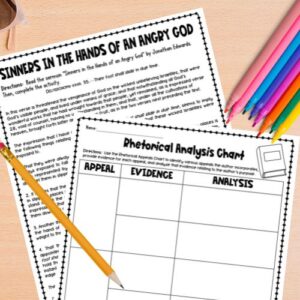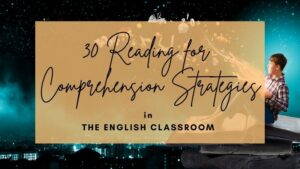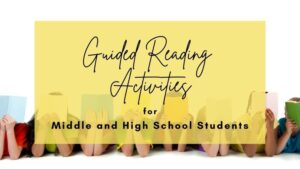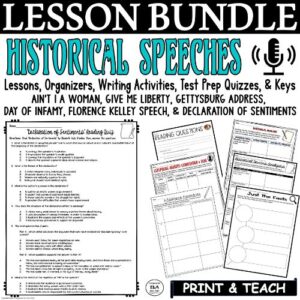After teaching high school English for the last seventeen years, I can honestly say that there is not a huge difference between teaching my kindergartener and teaching teenagers. Both have attitudes, depending on the day. Both get frustrated when some concept does not come easily. And both require extreme patience, flexibility, and determination when it comes to helping them become better readers, writers, and overall learners. Through the last two years or so of homeschooling my kiddo, I have been able to apply comprehension reading tips I learned over my time teaching high schoolers.
Simply put, learning how to grow as a reader and writer does not vary much from elementary school to high school. All students can benefit from the 7 Comprehension Reading Tips below!
Need help with Test Prep in which you can incorporate these comprehension reading tips? Check out this FREE Pack of 3 Test Prep Activities to help students achieve success on standardized tests!

7 Comprehension Reading Tips No Matter The Age
1. Read More.
This tip might seem obvious, but it is rarely applied. I get a lot of eye rolls from high school students when I tell them this. Let’s think about this concept though. In order to become a better basketball player, one must play ALL THE TIME.
It takes something like 10,000 hours to become a master at something, and this fact applies to reading as well. Unfortunately, we live in a world that surrounds us with so many fun, distracting activities that require little to no thought, let alone reading.
My goal for my own children is to read more. When we could turn on the television to watch a movie, we have to read first. Many times, we forget about watching something and just enjoy the reading ride.
For our students, we need to read more, not less. The idea of digging more deeply into a novel by taking nine weeks to read it sounds good on the surface, but really, kids need to simply read more texts. I wish I had a magical formula I could share with you, but it is as easy as this for most students.
But, like anything worth doing, it is hard. It takes consistent time, energy, and focus to read more when you are a struggling reader. As a parent and/or educator, taking 20-30 minutes out of your day to read with a child is life-changing. And let’s be real; ALMOST EVERYONE has 20-30 minutes to spare.
2. Read Again.
In order to develop a wide vocabulary and better fluency, children need repetitive exposure to the same or similar texts. Think about it. Young children love reading the same stories over and over again. And this repetition is what helps students later on with vocabulary and fluency.
When kids hear and see the same words repetitively, over time, they don’t need to use their phonics skills to break down the words. They simply know the words and/or phrases.
The same is true with high schoolers. There is nothing wrong with taking time to let students reread an excerpt, paragraph, passage, or entire text. Modeling this skill is vital. So often, students think they are not good readers when they have to reread something.
BUT rereading is a defining quality of a good reader.
Want more help with teaching reading comprehension? Check out 30 Reading For Comprehension Strategies!
3. Read Interesting Things.
I’m not a big fan of the word “fun” when it comes to education. Too often, the definition of “fun” is vague and unhelpful when choosing texts for students. I have had classes that LOVE certain texts because they are interesting, not because they are inherently fun like a rollercoaster ride. Every day cannot be a trip to the theme park.
For example, most educators might shy away from teaching “Sinners in the Hands of an Angry God.” My 10th-11th graders loved it when I taught this text. Usually, I had them learn about early American Literature and the effective use of rhetoric while reading. Because I taught something most of my students had not read, they were interested.
And well, I also made it interesting. I would read with extreme animation. I would question them along the way. I would emphasize the imagery created by Jonathan Edwards. This process helped them to realize that they could find reading a very old text engaging.
For my own child, I let her choose about half of what we read as a family; however, I also choose books she wouldn’t think of choosing. Normally, my choices revolve around picture books with higher-level vocabulary. Most of the time, she enjoys being exposed to unfamiliar topics. This exposure helps her cultivate her own personal reading habits.
We want this for our students as well!

Here is a list of my favorite pieces of fiction and nonfiction to teach in high school:
- “Sinners in the Hands of an Angry God”
- “A Modest Proposal”
- “The Lottery”
- “The Tell-Tale Heart”
- “Julius Caesar”
- “Song of Myself”
- “A Poison Tree”
- “Ain’t I a Woman”
- Declaration of Independence
- “I Hear America Singing”
- “A Vendetta”
- “Salvation”
- “The Cactus”
- “Gettysburg Address”
- “Declaration of Sentiments”
Check out my store Kristin Menke-Integrated ELA Test Prep! for lessons and activities for the above texts!
Here is a list of my favorite pieces of fiction and nonfiction to teach in middle school:
- “Click Clack the Rattle Bag”
- “The Veldt”
- “Song of Myself”
- “The Gift of the Magi”
- “Lamb to the Slaughter”
- “After Twenty Years”
- “The Raven”
- “Thank You, Ma’am”
- “The Pedestrian”
- “The Scarlet Ibis”
- “Paul Revere’s Ride”
Check out my store Kristin Menke-Integrated ELA Test Prep! for lessons and activities for the above texts!
4. Read Unexpectedly.
We go to the zoo…like a lot. And because we educate our kids at home, we have the time. One of my favorite parts of being able to homeschool is the ways we can integrate reading and these comprehension reading tips into whatever we do. And you don’t have to make it difficult or formal.
Unexpected reading ideas:
- Descriptions of animals at the zoo
- Menus at restaurants
- Ingredients at the supermarket
- Bible verses
- Articles you scroll to online
- Product details on websites
- Signs while driving
By incorporating these unexpected reading ideas above, you will make reading a natural part of the day. The unexpected will gradually become the norm in combination with using comprehension reading tips!
5. Read Together. (in combination with these comprehension reading tips)
Whenever I offer comprehension reading tips and advice to parents, unfortunately, they take it as their child needs to read more alone. Reading independently is helpful, but for a reluctant reader, it can also be a burden.
If we were honest, we would say that when we get home from work, we want to sit still, scroll videos, or watch television. Reading with our kids, especially middle and high school kids, is not at the top of our decompression list of things to do. BUT if you want your secondary students to become better readers, they need to read with other readers. Parents, like teachers, don’t have to be perfect readers. You as a parent or educator might not know every word. And that is okay.
Years ago, I tutored a second grader who read at a low kindergarten level. Looking back, I wish I would have focused on more phonics activities, but at the time, we just read a lot together. After talking with her mom, I realized one major truth. Her parents hadn’t read much with her as she grew up. I encouraged her mom and dad to read with her way more, but they were not excited about that prospect.
They wanted a quick and easy solution. Pay a tutor and set aside 1 hour a day about 2-3 times a week for reading instruction. Unfortunately, 2-3 hours a week of reading with a tutor will not replace the hundreds of hours missed from ages 0-8.
Reading with our students is just as important within the classroom. Of course, we want them to be able to read a text on their own; however, if a text is above their current reading level, it can be a waste of time. Students need to hear texts read aloud properly and with enthusiasm. For example, if you are teaching an Edgar Allan Poe story to a 9th grader who reads at a 6th-grade level, it is vital to read with that student. In fact, it even helps higher-level readers, because they can concentrate on meaning versus sounding out more difficult words. Poe is hard!
If you offer a bit of help in reading texts together combined with comprehension reading tips, it will reap great rewards.
Have you thought about developing guided reading activities for your own classroom? Check out THIS POST to help you with this process!
6. Read Independently.
It might seem like I am contradicting my previous tip to read together. I am not contradicting but simply adding on. Typically, students who read for 20-30 minutes a day will become proficient readers. And can you imagine the growth for those who CHOOSE to read for that time period or LONGER?
The problem I have with this statistic is that educational administrators have heard it and institute 30 minutes of required reading every day for their students. What the various studies don’t tell you is that the information connects to correlation and not direct causation.
The type of kid who chooses to read for that period of time will most commonly become a proficient reader; however, instituting it across a middle or high school arena will not yield the same results. If a student is not a competent reader by middle or high school, most likely, they will not magically become proficient through a program with required reading and the implementation of comprehension reading tips as a part of that program.
As educators, we can help a bit in several ways:
- Start students out with less time. A struggling reader may not last 20-30 minutes.
- Offer reading suggestions. Many times students need to know what is available.
- Give students a choice of some sort. Have fun short stories, graphic novels, or articles to read.
- Encourage parents/guardians to get involved. Simple reminders by phone or email to get students reading for 15 minutes at home will help tremendously.
- Get other teachers involved. So many history, science, and elective teachers want to help in some way, because their students may not read well. Reading and ELA teachers can provide quick paired texts that take less than 10 minutes to read independently.

7. Read Variety.
As a kid, I read a ton of fantasy and science fiction books. When I became a teenager, I started reading historical fiction. In school, we read the classics. As a teacher, I tended towards nonfiction. Now, I want to read anything that gives me help as a parent, entrepreneur, educator, and Christian.
Exposure to all of these genres has helped me in so many ways:
- It has developed my background knowledge.
- It has grown my vocabulary.
- It has helped me make better decisions.
- It has challenged my previous assumptions.
- It has made me a more fluent reader.
- It has increased my love of learning.
- It has encouraged me to become more discerning.
- It has magnified my courage.
When you only read from one perspective, one style, one genre, etc., you don’t grow as much as you could otherwise. Even as teachers we can get stuck on a specific writer, political ideal, educational theory, etc. Like our students, we need to provide more spice to our reading lives. We can accomplish this by reading a vast selection of texts and utilizing these 7 comprehension reading tips!
Why should we encourage these comprehension reading tips inside and outside of school?
Well, the answers to this question involving comprehension reading tips are simple:
- It is vital. People need to be able to read and comprehend a variety of complex texts throughout their lives.
- It is helpful. Having a list of go-to strategies can help teachers and parents alike.
- It is easy. The process, like losing weight, is easy. Eat less and more healthily, and you will see progress.
- It is simple. There is no magic formula, but there are 7 basic comprehension reading tips that produce optimal reading growth.
Click below to get this ready-made bundle of SIX speeches, lessons, activities, and quizzes to help you as you incorporate the above comprehension reading tips!
Need more ideas for teaching reading with comprehension reading tips? Check out my store Kristin Menke-Integrated ELA Test Prep!




